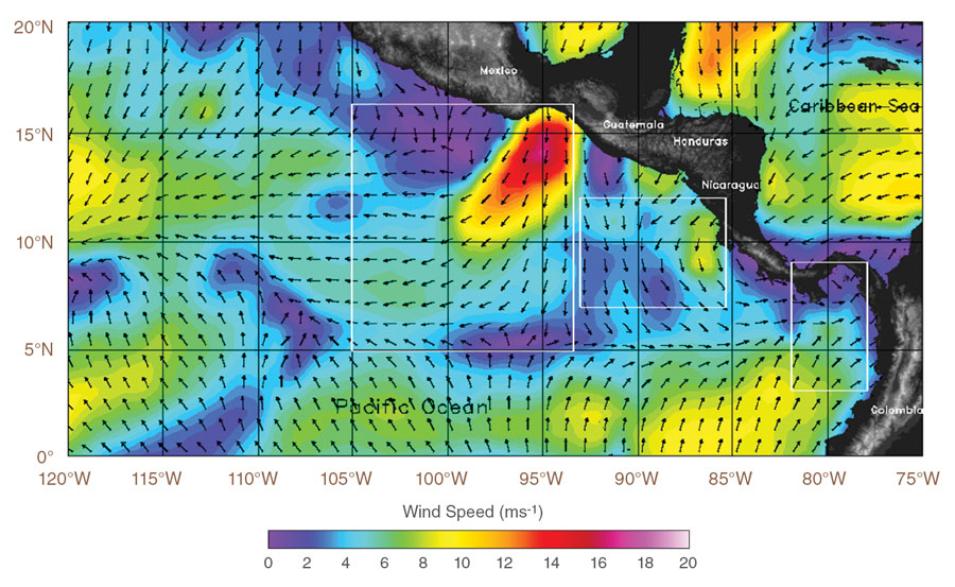The name of the wind
It is not just Central America that benefits from this algorithm. Other parts of the world could adapt it to build climatologies for their gap winds. The Mistral, for example, funnels through the valley of Rhone in southern France into the Mediterranean Sea. In Switzerland, there is the Jochwinde. In Greenland, there is the tip jet at the island’s southern end.
Mariners and pilots turn to global models for information about when these gap winds might happen. Smith said global models just do not have enough resolution for that. “The physics for these models are designed for larger-scale things, not these small scale regional features,” Smith said. Global models have a one degree resolution. The RASI climatology zooms into a quarter degree—just right for regional forecasts.
Emily Foshee, a graduate student at UAH, is now using the climatologies to develop a method to forecast the Tehuano, Papagayo, and Panama gap winds. The climatologies also promise to shed light on bigger puzzles. Keiser said, “The same tech we use to identify these features can be applied to hurricanes. The upwelling that gap winds cause can influence how hurricanes strengthen.” It might take some finagling, but the algorithm might help global models improve hurricane intensification forecasts.
To Smith, being able to study patterns in these climatologies is a powerful tool. “That’s where the RASI comes in. You can see the patterns,” she said. “Are they changing with global climate change and if so, have they started or ended earlier in the season? These questions can be explored because we now have this information. That’s very exciting.”
References
Li, X. and D. Smith. 2014. Regional Air-Sea Interaction (RASI) Gap Wind and Coastal Upwelling Events Climatology [indicate sites used]. Data sets available online [ftp://ghrc.nsstc.nasa.gov/pub/rasi/] from the NASA EOSDIS Global Hydrometeorology Resource Center Distributed Active Archive Center (GHRC DAAC) Huntsville, AL, U.S.A. doi:10.5067/MEASURES/RASI/DATA404.
NASA/GSFC/NOAA. 2009. Cross-Calibrated Multi-Platform Ocean Surface Wind Vector L3.0 First-Look Analyses. Ver. 1. PO.DAAC, CA, USA. doi:10.5067/CCF30-01XXX.
Ornelas, C. 2008. Adrift in el Istmo: a Kite Journey to Juchitán. Discourse: from the end of the line 1(3): 23–30. http://www.drachen.org/s3fs-public/pdf/Discourse%20Issue%203.pdf.
Remote Sensing Systems. 2011. GHRSST Level 2P Gridded Global Subskin Sea Surface Temperature from WindSat polarimetric radiometer on the Coriolis satellite. Ver. 7.0. PO.DAAC, CA, USA. doi:10.5067/GHWST-2GR01.
Remote Sensing Systems. 2011. AMSR-E Level 3 Sea Surface Temperature for Climate Model Comparison. Ver. 1. PO.DAAC, CA, USA.
Remote Sensing Systems. 2004. GHRSST Level 2P Global Subskin Sea Surface Temperature (SST) from the Tropical Rainfall Mapping Mission (TRMM) Microwave Imager (TMI). Ver. 4.0. PO.DAAC, CA, USA. doi:10.5067/GHTMI-2PR01.
Smith, D. K., X. Li, K. Keiser, and S. Flynn. 2014. Regional Air-Sea Interactions (RASI) climatology for Central America coastal gap wind and upwelling events. Paper presented at the OCEANS 2014 Marine Technology Society/Institute of Electrical and Electronics Engineers (IEEE) Conference, St. John, Newfoundland. doi:10.1109/OCEANS.2014.7003127.
For more information
NASA Global Hydrometeorology Resource Center Distributed Active Archive Center (GHRC DAAC)
NASA Physical Oceanography DAAC (PO.DAAC)
Regional Air-Sea Interactions


